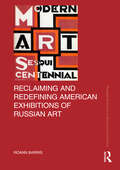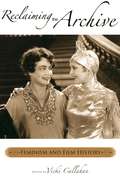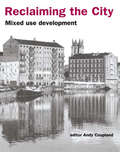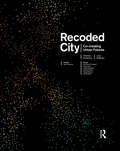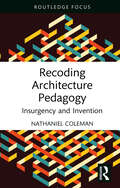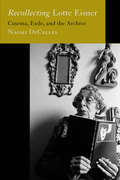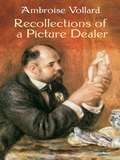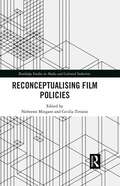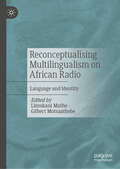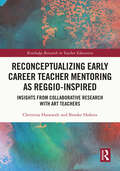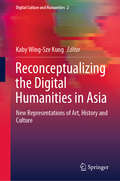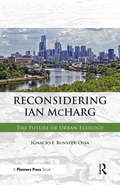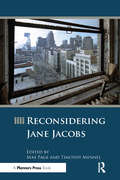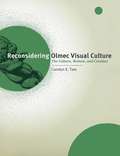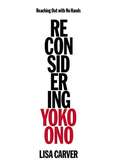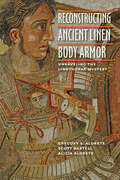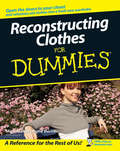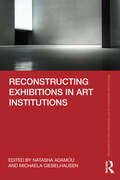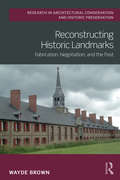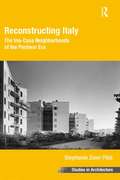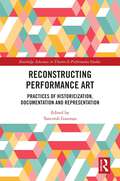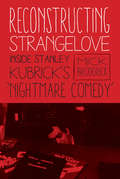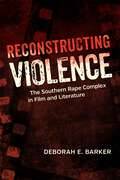- Table View
- List View
Reclaiming and Redefining American Exhibitions of Russian Art (Routledge Research in Art Museums and Exhibitions)
by Roann BarrisThis book examines the history of American exhibitions of Russian art in the twentieth century in the context of the Cold War. Because this history reflects changes in museological theory and the role of governments in facilitating or preventing intercultural cooperation, it uncovers a story that is far more complex than a chronological listing of exhibition names and art works. Roann Barris considers questions of stylistic appropriations and influences and the role of museum exhibitions in promoting international and artistic exchanges. Barris reveals that Soviet and American exchanges in the world of art were extensive and persistent despite political disagreements before, during, and after the Cold War. It also reveals that these early exhibitions communicated contradictory and historically invalid pictures of the Russian or Soviet avant-garde. The book will be of interest to scholars working in art history, museum studies, and Russian studies.
Reclaiming and Redefining American Exhibitions of Russian Art (Routledge Research in Art Museums and Exhibitions)
by Roann BarrisThis book examines the history of American exhibitions of Russian art in the twentieth century in the context of the Cold War. Because this history reflects changes in museological theory and the role of governments in facilitating or preventing intercultural cooperation, it uncovers a story that is far more complex than a chronological listing of exhibition names and art works. Roann Barris considers questions of stylistic appropriations and influences and the role of museum exhibitions in promoting international and artistic exchanges. Barris reveals that Soviet and American exchanges in the world of art were extensive and persistent despite political disagreements before, during, and after the Cold War. It also reveals that these early exhibitions communicated contradictory and historically invalid pictures of the Russian or Soviet avant-garde. The book will be of interest to scholars working in art history, museum studies, and Russian studies.
Reclaiming the Archive: Feminism and Film History
by Vicki CallahanReclaiming the Archive: Feminism and Film History brings together a diverse group of international feminist scholars to examine the intersections of feminism, history, and feminist theory in film. Editor Vicki Callahan has assembled essays that reflect a range of methodological approaches--including archival work, visual culture, reception studies, biography, ethno-historical studies, historiography, and textual analysis--by a diverse group of film and media studies scholars to prove that feminist theory, film history, and social practice are inevitably and productively intertwined. Essays in Reclaiming the Archive investigate the different models available in feminist film history and how those feminist strategies might serve as paradigmatic for other sites of feminist intervention. Chapters have an international focus and range chronologically from early cinema to post-feminist texts, organized around the key areas of reception, stars, and authorship. A final section examines the very definitions of feminism (post-feminism), cinema (transmedia), and archives (virtual and online) in place today. The essays in Reclaiming the Archive prove that a significant heritage of film studies lies in the study of feminism in film and feminist film theory. Scholars of film history and feminist studies will appreciate the breadth of work in this volume.
Reclaiming the City: Mixed use development
by Andy CouplandMixed use development is about retaining or creating a mix of different uses in cities or neighbourhoods. The trend in UK development has been towards specialisation and areas with single uses. Increasing the mix of uses is thought to reduce the need to travel, lower the likelihood of crime, improve the ambience and attractiveness of areas and contribute to the sustainability of cities.
Recoded City: Co-Creating Urban Futures
by Thomas Ermacora Lucy BullivantRecoded City examines alternative urban design, planning and architecture for the other 90%: namely the practice of participatory placemaking, a burgeoning practice that co-author Thomas Ermacora terms ‘recoding’. In combining bottom-up and top-down means of regenerating and rebalancing neighbourhoods affected by declining welfare or struck by disaster, this growing movement brings greater resilience. Recoded City sheds light on a new epoch in the relationship between cities and civil society by presenting an emerging range of collaborative solutions and distributed governance models. The authors draw on their own fresh research of global pioneers forging localist design strategies, public-realm interventions and new stakeholder dynamics. As the world becomes increasingly digital and virtual, a myriad of online tools and technological options is becoming available. These give unprecedented co-creation opportunities to communities and professionals alike, yielding the benefits of a more open – DIY – society. Because of its close engagement with people, place and local identity, the field of participatory placemaking has huge untapped potential. Responding to the challenges of the Anthropocene era, Recoded City is for decision-makers, developers and practitioners working globally to make better and more liveable cities.
Recoding Architecture Pedagogy: Insurgency and Invention (Routledge Focus on Design Pedagogy)
by Nathaniel ColemanDisabled by chasing curricular criteria (required for accreditation and professional registration), architecture schools are mostly compliance and reproduction machines serving the building industry. As a corrective, Recoding Architecture Pedagogy: Insurgency and Invention asserts disciplinary knowledge over professional skills as the proper aim and focus of architecture education. The insurgent pedagogy introduced subverts architecture and its teaching’s capture by capitalism’s dominant modes of production and consumption to reveal unexpected tactics for enlarging possibilities.Grounded in architecture histories and theories, philosophy, and anarchism’s emphasis on use and dissensus, combined with PUNK’s DIY ethos, design studio emphasis on technicity is upended to reveal the subversive aim of intensifying tensions between (doomed) desires for artistic autonomy and (intrinsic) burdens of use constituting architecture as a discipline, instead of seeking resolution, some neutral middle ground, or escape into banal practice or paper palaces.By concentrating on what architecture education suppresses (tensions), disavows (its capture within the building industry), or affirms (commercial practice over disciplinary knowledge), Recoding Architecture Pedagogy: Insurgency and Invention cracks open horizons of possibility by showing how intensifying agonistic relationships between the myriad binaries that characterize architecture and its teaching is generative, in ways conciliatory synthesis, cathartic resolution, and uncritical affirmation are not.
Recollecting Lotte Eisner: Cinema, Exile, and the Archive (Feminist Media Histories #3)
by Naomi DeCellesRecollecting Lotte Eisner provides the first in-depth examination of the remarkable transnational career of film journalist, archivist, and historian Lotte Eisner (1896–1983). From her early years as a film critic in interwar Berlin to her escape from prison in occupied France and from her role as chief curator at the Cinémathèque française to that as the mythic "collective conscience" of New German Cinema, Eisner was a prolific writer and lecturer and a pivotal voice in early film and media studies. Situated at the juncture of feminist media historiography and disciplinary intellectual history, this groundbreaking book is based on extensive multilingual archival research and the excavation of a rich corpus of previously overlooked materials. Introducing samples of Eisner's writing in translation, this volume makes some of the most important contributions of a foundational scholar in the field of film studies accessible for the first time to an English-language readership.
Recollections of a Picture Dealer
by Ambroise VollardCelebrity, art merchant, socialite, publisher, and writer, Ambroise Vollard (1867-1939) was one of the most extraordinary figures in 20th-century art. He possessed an uncanny ability to recognize genius in painters -- dozens of important artists received valuable commissions and gallery space with his help, and his galleries presented the first one-man shows for such luminaries as Matisse, Cézanne, and Picasso. Vollard's warmth, candor, and intelligence earned him the friendship of a generation of artists and make this memoir an enthralling and often hilarious account of an exciting Golden Age of painting.Vollard's anecdotal recollections transport the reader to Paris at the turn of the 20th century and the legendary "Street of Pictures," the rue Laffitte, where Vollard lived and worked. Rather than critiquing artists or esthetic movements, Vollard focuses on the human sidelights that made his life as picture dealer so rich and fascinating: his early efforts to sell the works of Cézanne, despite incredible opposition to Impressionism; his dinner parties, whose guests included Renoir, Forain, Degas, Redon, and Rodin; his many portrait sittings for Cézanne, Renoir, Rouault, Bonnard, Forain, and Picasso; his observation on the studios, habits, and personalities of Manet, Matisse, Picasso, de Groux, Signac, and Rousseau; and his encounters with Gertrude Stein, Alfred Jarry, Guillaume Apollinaire, Mallarmé, and Zola.
Reconceptualising Film Policies (Routledge Studies in Media and Cultural Industries)
by Nolwenn Mingant Cecilia TirtaineThis volume explores and interrogates the shifts and changes in both government and industry-based screen policies over the past 30 years. It covers a diverse range of film industries from different parts of the world, along with the interrelationship between different localities, policy regimes and technologies/media. Featuring in-depth case studies and interviews with practitioners and policy-makers, this book provides a timely overview of government and industry’s responses to the changing landscape of the production, distribution, and consumption of screen media.
Reconceptualising Multilingualism on African Radio: Language and Identity
by Gilbert Motsaathebe Limukani MatheThis book redefines multilingualism via the concept of radio in Africa. Africa presents unique challenges of lingual diversity which the media still struggles to accommodate, particularly when it comes to indigenous languages. Contributors argue that the linguistic realities of African radio reflect ethnic co-existence and fluidity of identity in pre-colonial, colonial and post-colonial contexts. They argue that communities consist of several “majorized” and “minoritized” indigenous languages which, if closely analysed, reflect a commonality of multilingualism. The book also suggests practical measures through which linguistic co-existence could be achieved and explores cases that redefine, reconceptualize and reframe multilingualism on African radio.
Reconceptualizing Early Career Teacher Mentoring as Reggio-Inspired: Insights from Collaborative Research with Art Teachers (Routledge Research in Teacher Education)
by Christina Hanawalt Brooke HofsessReconceptualizing Early Career Teacher Mentoring as Reggio-Inspired presents an innovative approach to early career art teacher mentoring informed by both the philosophy of Reggio Emilia and an ontology of immanence while simultaneously illuminating the experiences of the teacher-participants as co-inquirers within the contemporary milieu of public education in the United States. Readers are invited to travel with a group of teacher educators and early career PK-12 art teachers across a four-year journey to experience the evolving nature of a collaborative inquiry through mentoring-as-research, the Teacher Inquiry Group (TIG). The authors share significant insights regarding what it means to be an early career art teacher––especially in an educational climate steeped in neoliberal agendas, standardization, and accountability––and make potent suggestions for re-visioning entrenched approaches to mentoring and professional learning that better account for the inherent complexities of teaching in schools. Advocating for more complex understandings regarding teacher subjectivity and the contextual forces at work in schools, the authors provoke an expanded vision of how mentoring can be imagined, practiced, and lived in current educational contexts. The authors employ key orientations grounded in the Reggio Emilia philosophy to reimagine an under-researched and undertheorized area of study in art education-––early career teacher mentoring––that has implications for teachers at all levels and across all disciplines. This volume is essential reading for scholars and professionals across the fields of art education, teacher preparation, teacher education, and mentoring. It will appeal to educational researchers, K-12 practitioners, teacher educators, and administrators working with new teachers, as well as those interested in mentoring, Reggio Emilia, professional learning and development, art and aesthetic education, and emergent, process-oriented research methodologies.
Reconceptualizing Early Career Teacher Mentoring as Reggio-Inspired: Insights from Collaborative Research with Art Teachers (Routledge Research in Teacher Education)
by Christina Hanawalt Brooke HofsessReconceptualizing Early Career Teacher Mentoring as Reggio-Inspired presents an innovative approach to early career art teacher mentoring informed by both the philosophy of Reggio Emilia and an ontology of immanence while simultaneously illuminating the experiences of the teacher-participants as co-inquirers within the contemporary milieu of public education in the United States.Readers are invited to travel with a group of teacher educators and early career PK-12 art teachers across a four-year journey to experience the evolving nature of a collaborative inquiry through mentoring-as-research, the Teacher Inquiry Group (TIG). The authors share significant insights regarding what it means to be an early career art teacher––especially in an educational climate steeped in neoliberal agendas, standardization, and accountability––and make potent suggestions for re-visioning entrenched approaches to mentoring and professional learning that better account for the inherent complexities of teaching in schools. Advocating for more complex understandings regarding teacher subjectivity and the contextual forces at work in schools, the authors provoke an expanded vision of how mentoring can be imagined, practiced, and lived in current educational contexts. The authors employ key orientations grounded in the Reggio Emilia philosophy to reimagine an under-researched and undertheorized area of study in art education-––early career teacher mentoring––that has implications for teachers at all levels and across all disciplines. This volume is essential reading for scholars and professionals across the fields of art education, teacher preparation, teacher education, and mentoring. It will appeal to educational researchers, K-12 practitioners, teacher educators, and administrators working with new teachers, as well as those interested in mentoring, Reggio Emilia, professional learning and development, art and aesthetic education, and emergent, process-oriented research methodologies.
Reconceptualizing the Digital Humanities in Asia: New Representations of Art, History and Culture (Digital Culture and Humanities #2)
by Kaby Wing-Sze KungThis book examines new forms of representation that have changed our perception and interpretation of the humanities in an Asian, and digital, context. In analyzing written and visual texts, such as the use of digital technology and animation in different works of art originating from Asia, the authors demonstrate how literature, history, and culture are being redefined in spatialized relations amid the trend of digitization. Research studies on Asian animation are in short supply, and so this volume provides new and much needed insights into how art, literature, history, and culture can be presented in innovative ways in the Asian digital world. The first section of this volume focuses on the new conceptualization of the digital humanities in art and film studies, looking at the integration of digital technologies in museum narration and cinematic production. The second section of the volume addresses the importance of framing these discussions within the context of gender issues in the digital world, discussing how women are represented in different forms of social media. The third and final section of the book explores the digital world’s impacts on people’s lives through different forms of digital media, from the electromagnetic unconscious to digital storytelling and digital online games. This book presents a novel contribution to the burgeoning field of the digital humanities by informing new forms of representation and interpretations, and demonstrating how digitization can influence and change cultural practices in Asia, and globally. It will be of interest to students and scholars interested in digitization from the full spectrum of humanities disciplines, including art, literature, film, music, visual culture, media, and animation, gaming, and Internet culture."This is a well-written book, and I enjoyed reading it. The first impression of the book is that it is very innovative - a down-to-the-earth academic volume that discusses digital culture."- Professor Anthony Fung, Professor, Director, School of Journalism and Communication, The Chinese University of Hong Kong "This book has contributed to the existing field of humanities by informing new forms of representation and interpretations, and how digitization may change cultural practices. There is comprehensive information on how the humanities in the digital age can be applied to a wide range of subjects including art, literature, film, pop music, music videos, television, animation, games, and internet culture."- Dr Samuel Chu, Associate Professor, The Faculty of Education, The University of Hong Kong
Reconsidering Ian McHarg: The Future Of Urban Ecology
by Ignacio Bunster-OssaIn 1969 Ian McHarg laid out a new approach to land-use planning. His seminal work, Design by Nature, blazed the trail for sustainable urban development. The road was paved with good intentions. But where exactly did it lead? And where do we go from here? Reconsidering Ian McHarg offers a fresh assessment of McHarg’s lessons and legacy. It applauds his call for environmental stewardship while acknowledging its unintended results. For McHarg’s idyllic developments at the edge of nature turned greenfield sites into suburban communities. They added to sprawl and made America more dependent on cars. And they may even have delayed the kind of urban redevelopment needed to make today’s cities more sustainable.
Reconsidering Jane Jacobs
by Max Page Timothy MennelThis volume begins with the premise that the deepest respect is shown through honest critique. One of the greatest problems in understanding the influence of the author on cities and planning is that she has for much of the past five decades been "Saint Jane, the housewife" who upended urban renewal and gave us back our cities. Over time, she has become a saintly stick figure, a font of simple wisdom for urban health that allows many to recite her ideas and few to understand their complexity. The author has been the victim of her own success. This book gives this important thinker the respect she deserves, reminding planning professionals of the full range and complexity of her ideas and offering thoughtful critiques on the unintended consequences of her ideas on cities and planning today. It also looks at the international relevance – or lack thereof – of her work, with essays on urbanism in Abu Dhabi, Argentina, China, the Netherlands, and elsewhere.
Reconsidering Olmec Visual Culture: The Unborn, Women, and Creation
by Tate Carolyn E.Recently, scholars of Olmec visual culture have identified symbols for umbilical cords, bundles, and cave-wombs, as well as a significant number of women portrayed on monuments and as figurines. In this groundbreaking study, Carolyn Tate demonstrates that these subjects were part of a major emphasis on gestational imagery in Formative Period Mesoamerica. In Reconsidering Olmec Visual Culture, she identifies the presence of women, human embryos, and fetuses in monuments and portable objects dating from 1400 to 400 BC and originating throughout much of Mesoamerica. This highly original study sheds new light on the prominent roles that women and gestational beings played in Early Formative societies, revealing female shamanic practices, the generative concepts that motivated caching and bundling, and the expression of feminine knowledge in the 260-day cycle and related divinatory and ritual activities. Reconsidering Olmec Visual Culture is the first study that situates the unique hollow babies of Formative Mesoamerica within the context of prominent females and the prevalent imagery of gestation and birth. It is also the first major art historical study of La Venta and the first to identify Mesoamerica's earliest creation narrative. It provides a more nuanced understanding of how later societies, including Teotihuacan and West Mexico, as well as the Maya, either rejected certain Formative Period visual forms, rituals, social roles, and concepts or adopted and transformed them into the enduring themes of Mesoamerican symbol systems.
Reconsidering Yoko Ono
by Lisa CarverJohn Lennon once described her as “the world's most famous unknown artist: everybody knows her name, but nobody knows what she does.” Many people are aware of her art, and her music has always split crowds, from her caterwauling earliest work to her later dance numbers, but how many people have looked at Yoko Ono's decades-spanning career and varied work in total and asked the simple question, “Is it any good?” From her earliest work with the Fluxus group and especially her relationship with John Cage, through her enigmatic pop happenings (where she met John Lennon), her experimental films, cryptic books, conceptual art, and her long recording career that has vacillated between avant-garde noise and proto-new wave, earning the admiration of other artists while generally confusing the public at large who often sees her only in the role of the widow Lennon, Reaching Out with No Hands is the first serious, critical, wide-ranging look at Yoko Ono the artist and musician. A must-read for art and music fans interested in going beyond the stereotyped observations of Yoko as a Lennon hanger-on or inconsequential avant noisemaker.
Reconstructing Ancient Linen Body Armor: Unraveling the Linothorax Mystery
by Gregory S. Aldrete Alicia Aldrete Scott M. BartellA thorough and original study of the linothorax, the linen armor worn by Alexander the Great.Alexander the Great led one of the most successful armies in history and conquered nearly the entirety of the known world while wearing armor made of cloth. How is that possible? In Reconstructing Ancient Linen Body Armor, Gregory S. Aldrete, Scott Bartell, and Alicia Aldrete provide the answer.An extensive multiyear project in experimental archaeology, this pioneering study presents a thorough investigation of the linothorax, linen armor worn by the Greeks, Macedonians, and other ancient Mediterranean warriors. Because the linothorax was made of cloth, no examples of it have survived. As a result, even though there are dozens of references to the linothorax in ancient literature and nearly a thousand images of it in ancient art, this linen armor remains relatively ignored and misunderstood by scholars. Combining traditional textual and archaeological analysis with hands-on reconstruction and experimentation, the authors unravel the mysteries surrounding the linothorax. They have collected and examined all of the literary, visual, historical, and archaeological evidence for the armor and detail their efforts to replicate the armor using materials and techniques that are as close as possible to those employed in antiquity. By reconstructing actual examples using authentic materials, the authors were able to scientifically assess the true qualities of linen armor for the first time in 1,500 years. The tests reveal that the linothorax provided surprisingly effective protection for ancient warriors, that it had several advantages over bronze armor, and that it even shared qualities with modern-day Kevlar.Previously featured in documentaries on the Discovery Channel and the Canadian History Channel, as well as in U.S. News and World Report, MSNBC Online, and other international venues, this groundbreaking work will be a landmark in the study of ancient warfare.
Reconstructing Clothes For Dummies
by Miranda Caroligne BurnsReconstructing Clothes for Dummies offers inspiring projects and savvy tips on how to salvage those tired old clothes in your closet and turn them into a one-of-a-kind wardrobe. It shows craftsters, DIY enthusiasts, budget-conscious fashionistas and people from all walks of life how to unleash their inner fashion designer and transform outdated duds into hip new clothes. Featured projects include making good use of old scraps; reviving shrunken sweaters; finding redemption in that bridesmaid dress; decorative repair and embellishment of existing pieces; and creating unexpected home décor with what's hiding in your drawers.
Reconstructing Exhibitions in Art Institutions (Routledge Research in Art Museums and Exhibitions)
by Natasha Adamou Michaela GiebelhausenReconstructing Exhibitions in Art Institutions spans exhibition histories as anti-apartheid activism within South African community arts; collectivities and trade unions in Argentina; Civil Rights movements and Black communities in Baltimore; institutional self-critique within the neoliberal museum; reframing feminisms in USA; and revisiting Cold War Modernisms in Eastern Europe among other themes. An interdisciplinary project with a global reach, this edited volume considers the theme of exhibitions as political resistance as well as cultural critique from global perspectives including South Africa, Latin America, Eastern Europe, USA and West Europe. The book includes contributions by ten authors from the fields of art history, social sciences, anthropology, museum studies, provenance research, curating and exhibition histories. The edited volume finally examines exhibition reconstructions both as a symptom of advanced capitalism, geopolitical dynamics and social uprisings, and as a critique of imperial and capitalist violence. Art historical areas covered in the book include conceptualism, minimalism, modern painting, global modernisms, archives and community arts. This volume will be of interest to a wide range of audiences including art historians, curators, gallery studies and museum professionals, and also to scholars and students from the fields of anthropology, ethnography, sociology, and history. It would also appeal to a general public with an interest in modern and contemporary art exhibitions.
Reconstructing Historic Landmarks: Fabrication, Negotiation, and the Past (Routledge Research in Architectural Conservation and Historic Preservation)
by Wayde BrownHistoric reconstructions have been a consistent part of the historic preservation and heritage conservation movements in the United States and Canada. Indeed, reconstruction has been the primary tool at the most influential historic sites, for example: the Governor's Palace and the Capitol at Colonial Williamsburg, USA, and in Canada, the Fortress of Louisbourg. Dozens of other reconstructions have appeared during the past century in North America, undertaken by individuals, communities, states, and provinces, and by national agencies responsible for cultural heritage. Despite this prevalence, historic reconstructions have received little scholarly attention and the question of what motivated the proponents of these projects remains largely unexamined. This book explores that question through detailed studies of ten historic reconstructions located throughout Canada and the United States, ranging from 1908 to 2011. Drawing upon diverse archival sources and site investigations, the proponents of each site are given voice to address their need to remake these landmarks, be it to sustain, to challenge, or even subvert a historical narrative, or – with reference to contemporary heritage studies – to reclaim these spaces. Reconstructing Historic Landmarks provides a fascinating insight into these shifting concepts of history in North America and will be of considerable interest both to students and scholars of historic preservation and indeed to heritage professionals involved in reconstructions themselves.
Reconstructing Italy: The Ina-Casa Neighborhoods of the Postwar Era (Ashgate Studies In Architecture Ser.)
by Stephanie Zeier PilatReconstructing Italy traces the postwar transformation of the Italian nation through an analysis of the Ina-Casa plan for working class housing, established in 1949 to address the employment and housing crises. Government sponsored housing programs undertaken after WWII have often been criticized as experiments that created more social problems than they solved. The neighborhoods of Ina-Casa stand out in contrast to their contemporaries both in terms of design and outcome. Unlike modernist high-rise housing projects of the period, Ina-Casa neighborhoods are picturesque and human-scaled and incorporate local construction materials and methods resulting in a rich aesthetic diversity. And unlike many other government forays into housing undertaken during this period, the Ina-Casa plan was, on the whole, successful: the neighborhoods are still lively and cohesive communities today. This book examines what made Ina-Casa a success among so many failed housing experiments, focusing on the tenuous balance struck between the legislation governing Ina-Casa, the architects who led the Ina-Casa administration, the theory of design that guided architects working on the plan, and an analysis of the results-the neighborhoods and homes constructed. Drawing on the writings of the architects, government documents, and including brief passages from works of neorealist literature and descriptions of neorealist films by Pier Paolo Pasolini, Italo Calvino and others, this book presents a portrait of the postwar struggle to define a post-Fascist Italy.
Reconstructing Performance Art: Practices of Historicisation, Documentation and Representation (Routledge Advances in Theatre & Performance Studies)
by Tancredi GusmanThis book investigates the practices of reconstructing and representing performance art and their power to shape this art form and our understanding of it. Performance art emerged internationally between the 1960s and 1970s crossing disciplinary boundaries between performing arts and visual arts. Because of the challenge it posed to the ontologies and paradigms of these fields, performance art has since stimulated an ongoing debate on the most appropriate means to document, preserve and display it. Tancredi Gusman brings together international scholars from different disciplinary fields to examine methods, media, and approaches by which this art form has been represented and (re)activated over time and its transnational history reconstructed. Through contributions and case studies spanning various countries, regions and artistic fields, the authors outline an innovative theoretical-methodological framework for capturing the processes and strategies for transmitting the tangible and intangible heritage of performance art. This book will be of great appeal to students, researchers, and practitioners in the fields of Theatre and Performance Studies as well as Visual Arts and Art History, who have an interest in performance art, its history and presence in the contemporary artistic and cultural landscape.
Reconstructing Strangelove: Inside Stanley Kubrick's "Nightmare Comedy"
by Mick BroderickDuring his career Stanley Kubrick became renowned for undertaking lengthy and exhaustive research prior to the production of all his films. In the lead-up to what would eventually become Dr. Strangelove (1964), Kubrick read voraciously and amassed a substantial library of works on the nuclear age. With rare access to unpublished materials, this volume assesses Dr. Strangelove's narrative accuracy, consulting recently declassified Cold War nuclear-policy documents alongside interviews with Kubrick's collaborators. It focuses on the myths surrounding the film, such as the origins and transformation of the "straight" script versions into what Kubrick termed a "nightmare comedy." It assesses Kubrick's account of collaborating with the writers Peter George and Terry Southern against their individual remembrances and material archives. Peter Sellers's improvisations are compared to written scripts and daily continuity reports, showcasing the actor's brilliant talent and variations.
Reconstructing Violence: The Southern Rape Complex in Film and Literature (Southern Literary Studies)
by Deborah E. BarkerIn this bold study of cinematic depictions of violence in the south, Deborah E. Barker explores the ongoing legacy of the "southern rape complex" in American film. Taking as her starting point D. W. Griffith's infamous Birth of a Nation, Barker demonstrates how the tropes and imagery of the southern rape complex continue to assert themselves across a multitude of genres, time periods, and stylistic modes. Drawing from Gilles Deleuze's work on cinema, Barker examines plot, dialogue, and camera technique as she considers several films: The Story of Temple Drake (1933), Sanctuary (1958), Touch of Evil (1958), To Kill a Mockingbird (1962), and Cape Fear (1962). Placing this body of analysis in the context of the historical periods when these films appeared and the literary sources on which they are based, Barker reveals the protean power of cinematic racialized violence amid the shifting cultural and political landscapes of the South and the nation as a whole. By focusing on familiar literary and cinematic texts--each produced or set during moments of national crisis such as the Great Depression or the civil rights movement--Barker's Reconstructing Violence offers fresh insights into the anxiety that has underpinned sexual and racial violence in cinematic representations of the South.
